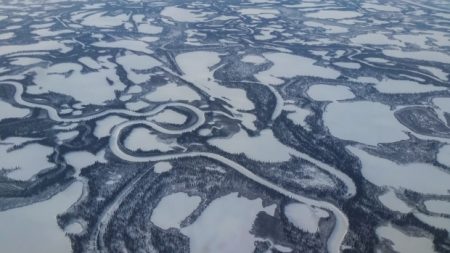July 21, 2017 – Permafrost is a great carbon sink except when it is melting. And that’s what is happening in Canada’s Arctic. Methane (CH4) release is changing the appearance of pockets of permafrost in the Northwest Territories. In some cases, the thaw occurring over only 1% of the surface area is releasing 13 times the amount of CH4 that normally would come from bacterial decomposition.
Some of this CH4 is clearly not just derived from organic decomposition. Locked beneath the permafrost are pockets of fossil natural gas that seep through faults and cracks into the permafrost and local lakes eventually to be released into the atmosphere.
The findings come from two years of atmospheric sampling above 1% of Canada’s permafrost over the Mackenzie River delta (seen in the photograph below). That 1% is contributing 17% of all the CH4 measured in the high Arctic. Imagine then what the remaining 99% can potentially contribute with an increased partial permafrost thaw.

This new study concludes that the higher concentration of CH4 has geologic and largely nonorganic origins. So under the Mackenzie River delta, there are likely significant pockets of natural gas.
Nonetheless, CH4 releases from under or within the permafrost represent a significant greenhouse gas threat, 28 times more potent than carbon dioxide (CO2) the gas most associated with global warming studies. CH4 may dissipate much sooner than CO2 but a massive release of it could cause a significant temporary spike in global temperatures.
In a recent study by the U.S. Geological Survey, it estimated that between 16 and 24% of its Alaska permafrost is expected to melt by 2100. The implications for a CH4 release from rapid warming just from Alaska alone cannot be underestimated. But the larger permafrost basins lie in Canada and Siberia. And in the latter there is plenty of evidence of significant CH4 releases causing gigantic sinkholes which have led to the release of buried pathogens causing human and animal deaths.








